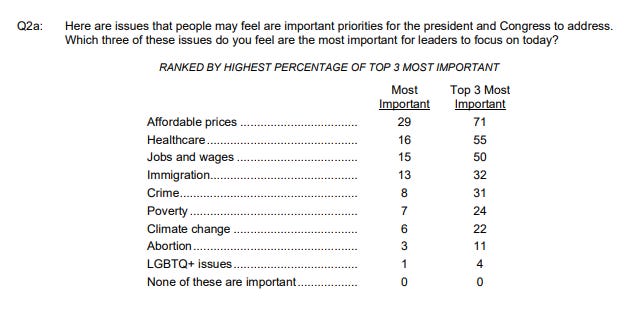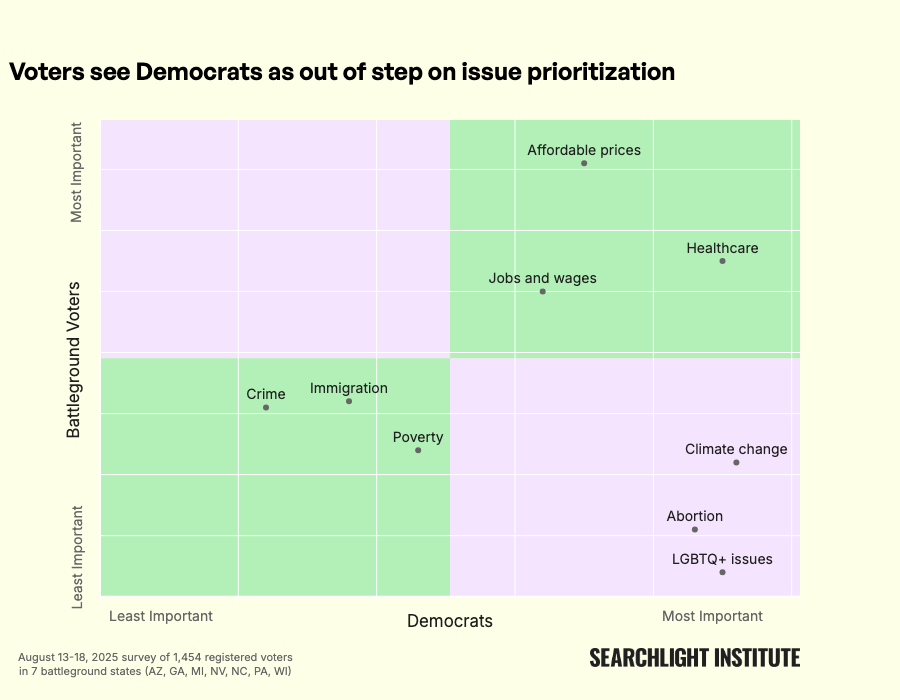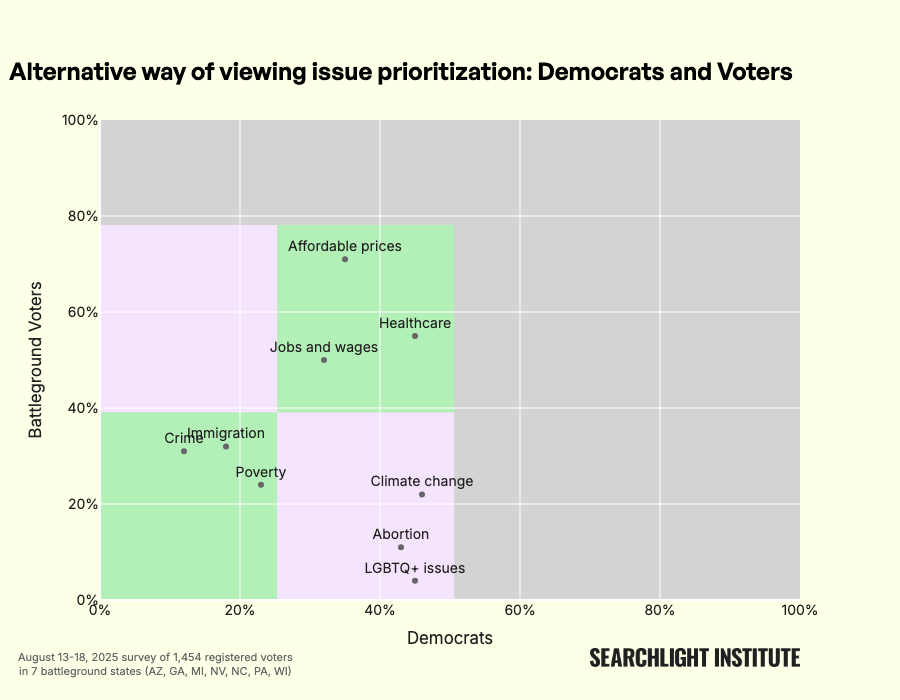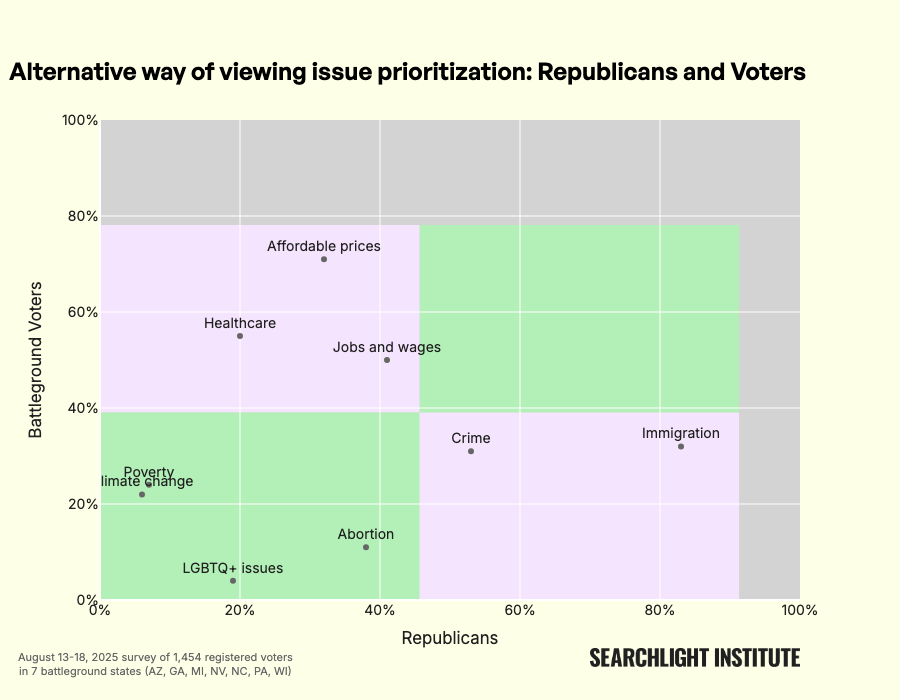Deep Dive - Polling Issue Prioritization
One of the key pieces in our Climate and Energy poll is a point about issue prioritization. You should read the whole memo, but the gist of it is that while voters care about climate change and think it’s a problem, it’s not a top issue they want addressed. Other issues like prices and healthcare are much more top of mind for them. How do you get at that rank order priority? One way to do it is like this:
Rather than trying to get each individual respondent to produce a rank order of all the issues, which can be complex and tricky for people, you ask each respondent to pick a few top issues and get the rank order from the aggregate responses.
For this piece, we compared the prioritization of issues by voters to the way they see Democrats/Republicans prioritizing, and saw a pretty massive disconnect. Here’s the visual I used in the writeup:
This looks extremely straightforward, but the underlying data is slightly more complex, as are the choices you have to make in visualizing it. In the graph above, I ended up scaling each axis from zero to just over the max percentage given to any issue. So, 71% of voters had “affordable prices” in their top-three issues. As such, the y axis is bounded at about 78%. The thinking is that the relative prioritization of issues is more important than the absolute numbers of voters including each issue in their top-three, so we should scale the axis to highlight that relative prioritization.
You could easily make different choices.
Here’s that same exact graph, but with the axes set zero to one. I left the colors from the initial graph in there so you can really see what portion is included in the initial visualization. You can still see the cluster of issues that voters think Democrats highly prioritize (healthcare, climate change, abortion, LGBTQ+ issues), but now it’s much more clear that voters have a much larger spread in how much they care about issues. While Democrats are seen as having several issues roughly tied for top priority, voters have a 16 point gap between “affordable prices” and the runner up, "healthcare." That doesn’t necessarily mean anything—it could be a complete artifact of the survey—but it’s also possible it shows a more intense priority order than the Democratic ranking.
Voter perception of Republican priorities has almost the opposite structure to perception of Democratic priorities. There’s a super intense focus on immigration, with every other issue trailing far behind, and poverty/climate change nearly at zero. I did the same scaling of the colored quadrants here as above, based on the bounds of data on each axis. You can see how it might obscure trends that are present! Does this show Republicans being out of step on “jobs and wages,” when 51% of voters say it’s a top-three issue and 41% say it’s a top-three issue for republicans? Probably not. Does it show Republicans out of step on “immigration,” with 31% vs 83%? I’d say absolutely yes.
I tend to think the rank order is more important than the absolute percentages putting each issue in their top-three, especially since we aren’t using the rank within that top-three in this calculation. However, there’s clearly *some* information in the gaps between each issue, as you can see from the bit about Republicans on immigration. The spread of how voters see each party to prioritize issues clearly contains some information, but it’s hard to know if a tight spread (like on the Democratic side) indicates the party is focusing on many issues at once, or that voters just aren’t getting clear information about party priorities. Similarly, on the Republican side, the super high immigration number could represent really clear branding, or just the influence of current events.
This is why our data principles have a section on “Nuance.” Polling questions are often subject to multiple interpretations, and have many points where whoever is presenting them can add their own subjective view. The best results will always come from looking at multiple types of work over time—which is why I was reassured to see our poll results matching up with a NYT/Ipsos poll that tried something similar. Issue prioritization is something I can guarantee we will come back to.







So things have come full circle and we're back to Carville's "it's the economy, stupid." Or rather, should we say, "it's the economy, because you're stupid," and are incapable of considering issues that go beyond day-to-day challenges? So the most existential problem humanity faces—climate change, is the new "don't ask don't tell," and falls off the Democratic platform. What's next, the wholesale abandonment of science because the average voter is incapable of understand complex issues? The Democratic party has never adopted this kind of strategy and yet has won many elections. Why? Because it took the time to explain issues to voters. It engaged and sought consensus on how to address these complex issues, rather than abandoning them. The real reason we are at this point is not because we failed to feed pablum to the masses, but because of Joe Biden's ego. Had Biden announced early in his term that he was not going to seek re-election, the Democrat Party would have held a real primary and voters wouldn't have felt Harris (a nonetheless highly qualified candidate) was being forced upon them. That is the real issue facing the Democrat party.
I’m firmly in the camp of climate change being an existential threat, but the Republican party and the petroleum and coal industries have done an excellent job (with lots of funding) to introduce doubt and politics into the discussion. Just like with education, medicine and science in general. You can keep trying to educate an American public that seems less interested or less capable of understanding, or you can “lighten” the topic and appeal to their priority concern - energy costs. Having true villains to infuse into the discussion obviously doesn’t hurt. If I were running for office - this is the kind of stump or one minute speech I’d give on the topic. Obviously I’d want to have some facts at hand to back this up if I were actually running for office.
“Republicans and the coal and petroleum industry are directly responsible for driving your utility bills higher. In order to line their pockets and keep their monopolies, they’re lying to you about the cheaper costs of energy sources such as solar and wind. They don’t want you, or the utility companies, to have the ability to choose the least expensive options. Republicans are denying you your right to choose what’s best for you and your family, because they put coal and petroleum executives - the people who funded their campaigns - first. Sure - Donald Trump is making up all kind of his usual insanity about wind and solar power, but it’s not because of birds, whales, or some golf course in Scotland - it’s because he needs to keep his promises to the coal and petroleum executives. It’s that simple.”
There are numerous studies that demonstrate the lower costs of solar and wind - the question is whether including these would really be that helpful in the messaging. The same could be said about Trump’s well documented record of strong arming petroleum industry executives for money in return for favors.